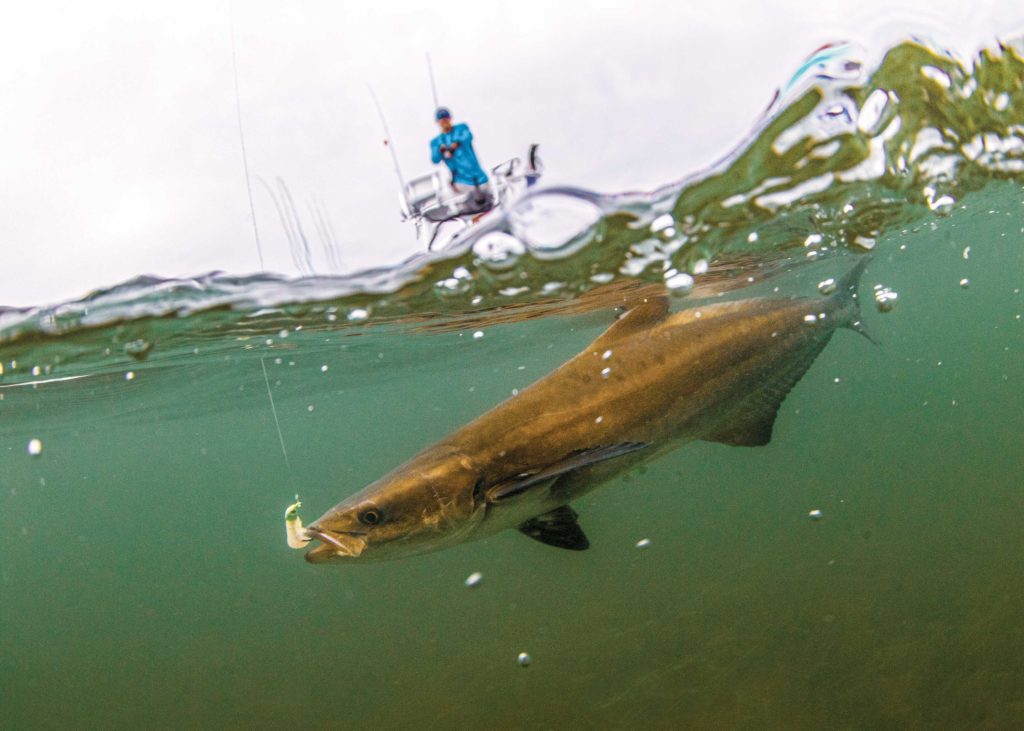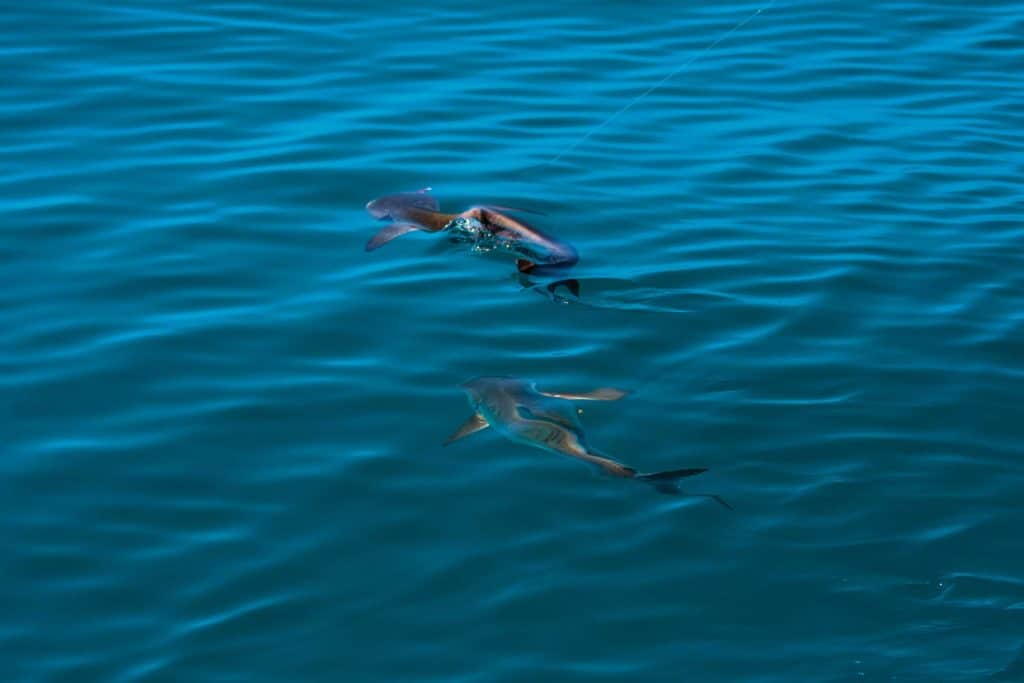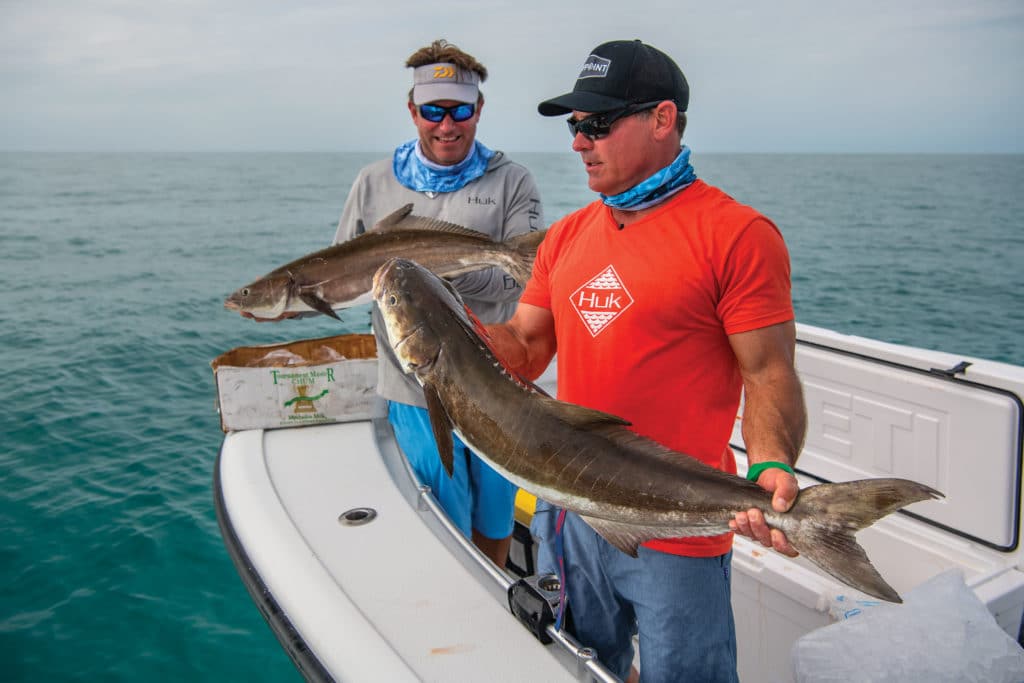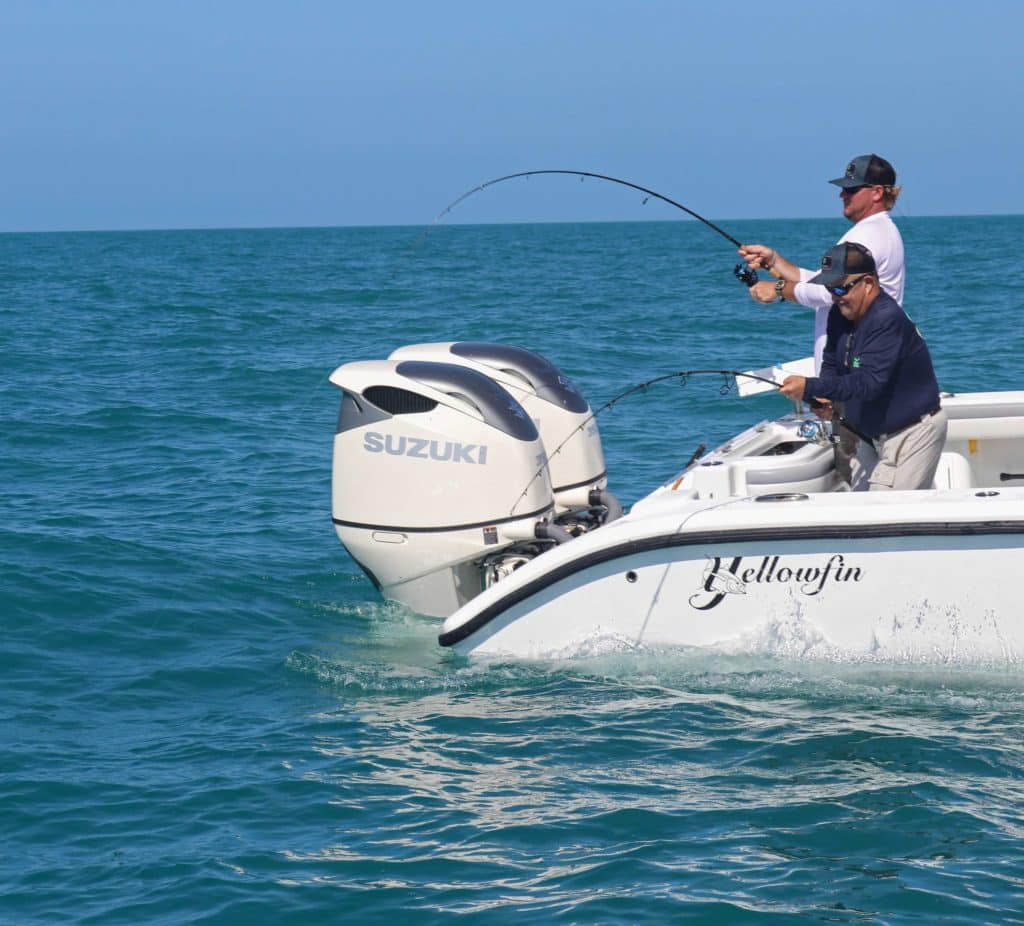
I scooped a big, lazy pinfish out of the bait well and hooked it onto a heavy bucktail jig, so it hung like an old-fashioned pork-rind trailer. “Get your lure to the bottom, as fast as you can,” advised Robert “RT” Trosset, keeping an eye on the echo sounder and the mass of fish gathering beneath us.
I made bottom, reeled up two short cranks, and worked the jig with a strong lift-and-drop action. I was about to ask RT if I was doing it correctly, when the line stopped cold. One sharp thump through the rod tip, followed by the rod doubling over and line pouring off the reel, told me all I needed to know. “Yeah, do that,” he advised.
On this sunny late-winter weekend, I was with RT and his son Chris, one of Key West’s most sought-after light-tackle guides in his own right.
Anchored within shouting distance of each other, near a remote and rust-pocked radio platform in the Gulf of Mexico, we enjoyed epic fishing for hard-fighting cobia until our arms were sore.
In typical Key West fashion, it seemed the only thing that stopped us from catching cobia were the amberjack, jack crevalle, mutton snapper, African pompano, barracuda and occasional bull shark that grabbed our baits.
Cobia concentrate around Key West from January through March.
“We have two runs of cobia: one in the winter and one in the spring,” RT says. “In the springtime, we’ll often catch them on the color change while fishing for sailfish. We always have a setup rigged and ready to cast if we see one on the surface.” During winter, it’s a down-on-the-bottom, tight-to-structure game.
Cobia hang on reefs, wrecks, navigational markers, and anywhere baitfish are found. And both the Gulf and Atlantic waters off Key West are target-rich environments.
“We mainly fish on the Gulf side when targeting cobia, but we have plenty of good spots in the Atlantic as well,” Chris says. “We focus on wrecks and reefs from 25 to 120 feet deep.”
Gear for this fishing is simple, with both RT and Chris favoring Penn Slammer 6500 spinning reels spooled with 30- to 50-pound braid, and a few feet of 50- or 60-pound fluoro leader. Cobia, aggressive feeders, slam white or chartreuse bucktail jigs dressed with a live or dead baitfish, strips of squid, or even a plastic curly tail. Jigs vary from 3/4 to 4 ounces, as current speed requires.
Set for Success
Most of the time, Robert and Chris set anchor up-current of structure, and deploy frozen-block chum to establish a scent trail. This usually collects a variety of species in the slick, which triggers both the interest and predatory instincts of cobia.
The trick is to work lures close to the bottom without hanging up.
“The stronger the current, the closer the cobia hang to the bottom,” Robert says. Chris recommends working the jig aggressively, but keeping it low in the water column.
“If you get up too high off the bottom, you’re likely to get bit by jacks, kingfish, or other species you’re not after.”

When cobia hold on a spot, they are usually aggressive biters, but not always. “If cobia are picky, I’ll put down a light rig with cut bait and start catching lane snapper and other small fish down near the bottom. The feeding activity and struggling fish seem to trigger the cobia and make them more active,” Chris says. This competitive response is another reason why cobia frequently follow a hooked fish to the boat, and why both Trossets keep an outfit ready to drop a jig to these volunteers.
When the current begins slack, small packs of cobia often rise off the bottom to hunt near the surface. When you see this, it’s smart to keep an eye on the chum slick, stay alert for the distinctive brown profile, and be ready to cast a bucktail to prowlers.
“If you get a cast in front of them where they can see it, they usually hit it,” Robert says. If they don’t hit at first, he sneaks the lure into their field of vision from behind, which triggers a fast reaction bite from finicky fish.

Seal the Deal
Cobia are big, strong, and live close to craggy structure. Fortunately, they are not known for diving, and usually come off the bottom to fight. The key to landing cobia is maintaining steady pressure at all times. They tend to shake their heads violently, and slack in the line can cause heavy bucktails to tear loose. It is also important to fight the fish until it’s good and tired.
Read Next: Cobia Fishing Guide
“Believe me, you don’t want to gaff a green cobia,” Chris says. “This is the one fish I try not to hit in the head; I stick them below the dorsal fin and quickly lift them into the boat.” Staying well clear for a while is another piece of sage advice. Like big Alaskan halibut and bull dorado, cobia have a way of clearing a cockpit once they hit the deck.
If the idea of catching big cobia has you keyed, the cure is easy: Get into the game.

Keys Cornucopia
The same wrecks and reefs that attract cobia teem with variety. While some of us targeted cobia, other anglers in our group kept busy pulling on big amberjack and jack crevalle on live bait, surface plugs and fly gear. Come prepared for all types of fishing, and don’t be afraid to go off-script to sample the range of opportunity this world-class angling destination has to offer.
Fishing Central
Ocean’s Edge Resort & Marina provides traveling anglers with accommodations and access to an extensive fleet of charter boats (including the Trossets’) right outside your door. You have a choice of the best charter captains in the fleet, and everything from luxury yachts to bluewater center-consoles and flats skiffs. At the end of the day, the restaurant gladly prepares your catch in a variety of ways.
Planner
What: Jigging for winter cobia
When: January through March
Where: Key West, Florida
Who: For anglers serious about tangling with these distinctive fish (think part shark, part giant remora), Key West is the place and winter is the time. Robert Trosset’s personal best is a 93-pound trophy, but the area offers solid action with 15- to 30-pound fish, and the occasional 40- to 50-pounder.
Capt. Robert Trosset
spindriftfishing.com, 305-797-5693
Capt. Chris Trosset
reelflykeywest.com, 305-747-4719
Capt. Anthony Solmo
gotemonsportfishing.com, 954-621-7890
Tackle Box
Reels: Penn Slammer 6500 spinning reel or equivalent
Rods: 7-foot Penn Carnage II spinning rod or equivalent, rated for 20- to 40-pound line
Line: 30- to 50-pound braid
Leader: 6 to 8 feet of 50- to 60-pound fluorocarbon
Bait: 3/4- to 4-ounce bucktail jigs in white or chartreuse









